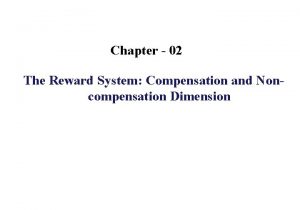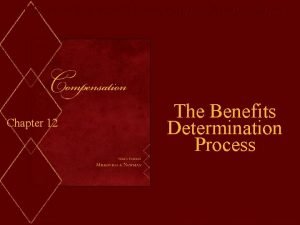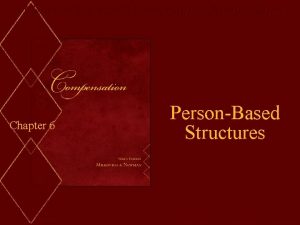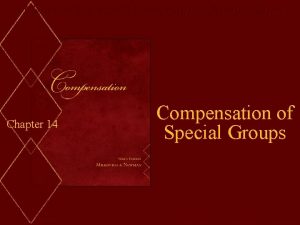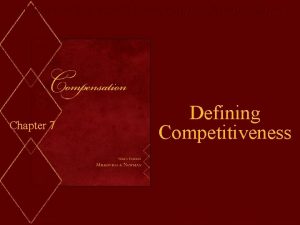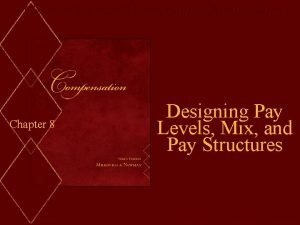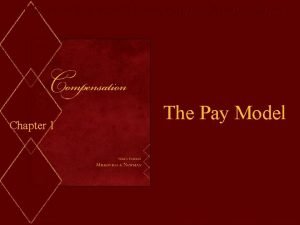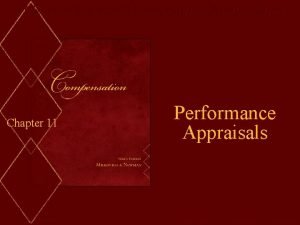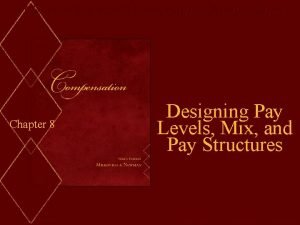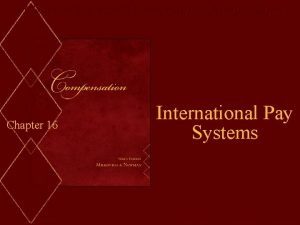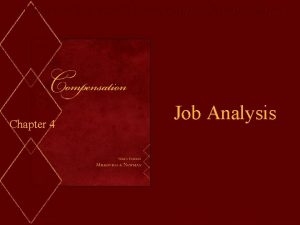MilkovichNewman Compensation Ninth Edition Chapter 18 Mc GrawHillIrwin














- Slides: 14

Milkovich/Newman: Compensation, Ninth Edition Chapter 18 Mc. Graw-Hill/Irwin Budgets and Administration Copyright © 2008 by The Mc. Graw-Hill Companies, Inc. All rights reserved.

Exhibit 1. 5: THE PAY MODEL POLICIES ALIGNMENT COMPETITIVENESS CONTRIBUTORS TECHNIQUES Work Descriptions Evaluation/ INTERNAL analysis certification STRUCTURE Market Surveys definitions Seniority based Policy lines Performance based Merit guidelines OBJECTIVES PAY STRUCTURE EFFICIENCY • Performance • Quality • Customers • Stockholders • Costs INCENTIVE PROGRAMS FAIRNESS COMPLIANCE MANAGEMENT Costs Communication Change EVALUATION 18 -2

Managing Labor Costs n Financial planning is integral to managing compensation – Total compensation makes up at least 50 percent of operating expenses in many orgs § But, most orgs have not tried to analyze returns from their compensation decisions (e. g. , increases expected from new gainsharing plan, expected value of increasing merit increases for top performers relative to average performers) 18 -3

Controlling Employment: Staffing Levels and Hours n Staffing Levels – Most common approach to managing labor costs is to control number of ees a/o hours worked § Note: layoffs and plant closings often have positive shortrun effect on stock price, but loss of human capital and lowered morale may well lead to lower performance than anticipated § Contingent workforce is a possible buffer 18 -4

Control Salary Level: Top Down n Top management determines the amount of money to be spent on pay and allocates it “down” to each subunit for the plan year – Current year’s rise – Ability to pay – Competitive market – Turnover effects 18 -5

Control Salary Level: Bottom Up n. Instruct managers in compensation policies and techniques n. Distribute forecasting instructions and worksheets n. Provide consultation to managers n. Check data and compile reports 18 -6

Control Salary Level: Bottom Up (cont. ) n. Analyze forecasts n. Review and revise forecasts and budgets with management n. Conduct feedback with management n. Monitor budgeted versus actual increases 18 -7

Embedded Controls n Range maximums and minimums n Compa-ratios n Variable pay n Analyzing costs n Analyzing Value Added 18 -8

Exhibit 18. 9: Illustration of Value-Added Analysis 18 -9

Communication: Managing the Message n Compensation communicates n Employee’s understanding of the pay system is shaped – Indirectly through the paychecks they receive – Directly via formal communication about their pay, their performance, and the markets in which the organization competes 18 -10

Why Communicate Pay Information? n Devotion of considerable resources to designing a fair and equitable system intended to – Motivate effective performance – Encourage productivity n Misperception of pay system by employees n Openness about pay may – Engender goodwill – Affect perceptions of pay equity 18 -11

Pay: Change Agent in Restructuring n Pay often plays a singular role when organizations restructure n Strategic changes in business strategy mean the pay strategy must be realigned – Changing people’s pay captures their attention n Pay changes play two roles – Catalyst for change – Follower of change 18 -12

Structuring the Compensation Function n Centralization versus decentralization n Flexibility within corporate-wide principles n Reengineering and outsourcing 18 -13

Controls as Guidelines: Let (Thoughtful) Managers Manage n Traditional compensation plans often degenerate into bureaucratic nightmares that hinder the organization’s ability to respond to competitive pressures – Reducing the controls and guidelines inherent in any pay plan recommended § Banding eliminates or at least reduces the impact of range maximums and minimums § Replacing merit grids with bonuses § Replacing job evaluation with skill- or competency-based plans 18 -14
 Psychology ninth edition in modules
Psychology ninth edition in modules Macroeconomics mankiw 9th edition
Macroeconomics mankiw 9th edition Human anatomy & physiology edition 9
Human anatomy & physiology edition 9 Psychology ninth edition david g myers
Psychology ninth edition david g myers Social psychology ninth edition
Social psychology ninth edition Biology ninth edition
Biology ninth edition Laura e berk child development (9th edition pdf)
Laura e berk child development (9th edition pdf) Child development 9th edition
Child development 9th edition Lysanx
Lysanx Psychology ninth edition in modules
Psychology ninth edition in modules Psychology ninth edition in modules
Psychology ninth edition in modules Biology ninth edition
Biology ninth edition Campbell ninth edition
Campbell ninth edition Noncompensation
Noncompensation What shapes internal structure
What shapes internal structure













